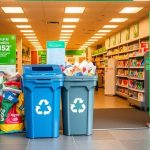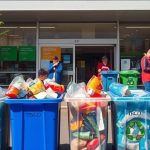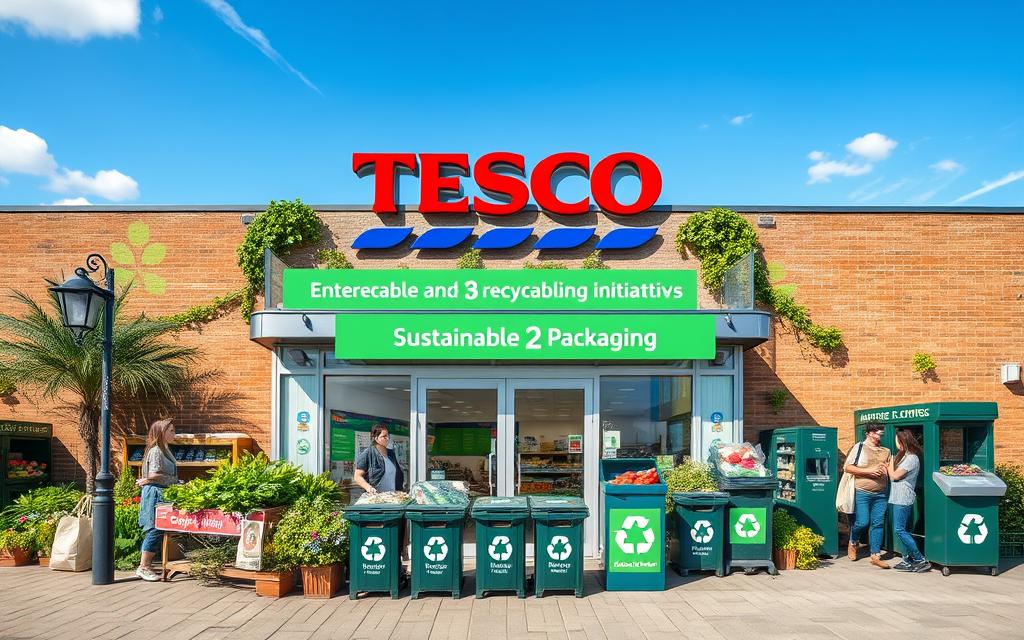Tesco Carrier Bag Recycling: A Sustainable Choice
Tesco is revolutionising carrier bag recycling with innovative sustainability strategies. The retailer has transformed plastic waste reduction into a strategic initiative. They’ve introduced sustainable shopping bags that challenge traditional packaging approaches.
Tesco has launched bags made from recycled plastic in Eastern European markets. This initiative aims to cut plastic bag sales by 22 million annually. It shows Tesco’s commitment to environmental stewardship.
The company’s approach to carrier bag recycling goes beyond simple replacement. Tesco has removed 1 billion plastic pieces from its portfolio. They’re targeting an additional 0.5 billion pieces this year.
Sustainability is a strategic business model for Tesco. They plan to make all Tesco-label packaging reusable or recyclable by year-end. This positions Tesco as a leader in sustainable shopping solutions.
Tesco’s strategy includes collection points in 800 large stores. This allows customers to take part in the recycling ecosystem. It turns sustainable shopping bags into a tangible, accessible reality.
Understanding Tesco’s 4Rs Packaging Strategy
Tesco’s 4Rs packaging strategy tackles plastic waste and environmental responsibility. This approach goes beyond traditional waste management. It represents a holistic method to address sustainable packaging.
- Remove: Eliminating unnecessary packaging materials
- Reduce: Minimising packaging where complete removal isn’t possible
- Reuse: Promoting circular packaging solutions
- Recycle: Ensuring maximum recyclability of packaging materials
Remove and Reduce Initiatives
Tesco has improved packaging for over 1,600 products. This effort saved more than 6,000 tonnes of material. The company removed nearly 1.5 billion pieces of plastic from packaging.
Reuse and Recycle Programmes
The retailer launched innovative initiatives to promote reusable packaging. These include:
- A reusable shopping service with Loop in 10 stores
- Soft plastic recycling collection points in larger stores
- 88 products available in the Loop reusable packaging initiative
Material Selection Process
| Material Category | Recyclability | Usage Status |
|---|---|---|
| Green Materials | Easy to Recycle | Preferred |
| Amber Materials | Moderate Recyclability | Restricted |
| Red Materials | Difficult to Recycle | Discouraged |
Tesco aims to achieve fully recyclable packaging by 2025, with 86% of own-brand packaging already recyclable in 2022-23.
Tesco’s 4Rs strategy shows their dedication to sustainable packaging. It tackles environmental issues through clever design and smart material choices.
The Journey of Tesco Carrier Bag Recycling
Tesco leads the way in sustainable carrier bags with its closed-loop recycling programme. The retailer turns recycled plastic bags into new packaging. This shows Tesco’s dedication to cutting down on environmental waste.
The recycling process starts with collection. Tesco set up soft plastic recycling points in March 2021. Customers can now return packaging at store locations. This effort allows Tesco to gather 1,000 tonnes of soft plastic yearly.
“Our goal is to create a sustainable cycle of plastic usage,” says a Tesco sustainability representative.
Key aspects of Tesco’s recycled plastic bags programme include:
- Collecting 100% recycled plastic bags
- Using 80% post-consumer plastic waste
- Incorporating 20% recycled production waste
International partnerships are vital to this process. Tesco works with Eurokey Recycling in Poland. Here, collected soft plastics are sorted and processed.
Tracking studies have revealed intriguing facts about the global recycling journey. Some plastic items travel hundreds of miles before being recycled.
Tesco is determined to build a nationwide recycling network for sustainable carrier bags. This programme tackles a major environmental issue. Current estimates suggest UK supermarkets produce about 800,000 tonnes of plastic yearly.
Environmental Impact and Sustainable Solutions
Tesco’s environmental sustainability is key to its corporate strategy. The retailer has made big strides in reducing plastic waste and its carbon footprint. They’ve done this through clever packaging solutions.
Plastic Waste Reduction Goals
Tesco has shown great progress in managing its environmental impact. Since 2019, they’ve removed 2.3 billion pieces of plastic from their operations. This is due to their 4Rs strategy.
In the last year, they’ve eliminated 500 million plastic pieces. Over 1.5 billion pieces have been removed from UK operations. New packaging has cut over 10 million pieces of plastic yearly.
- Elimination of 500 million plastic pieces in the last 12 months
- Removal of more than 1.5 billion pieces of plastic from UK operations
- Reduction of over 10 million pieces of plastic annually through new packaging
Carbon Footprint Considerations
Tesco aims to cut its carbon footprint across the board. They’ve set bold targets to use more renewable energy. They’re also working on sustainable packaging solutions.
| Environmental Metric | Current Performance |
|---|---|
| ESG Environmental Score | 78 |
| Soft Plastic Recovery Rate | 80% |
| Monthly Soft Plastic Recycling | 25 tonnes |
Comparison with Alternative Materials
Tesco has replaced plastic packaging in many product lines. Their Finest dried pasta now uses 100% recyclable paper bags. These bags can be recycled at home.
This new approach covers 10 product lines. It includes various pasta types like orzo, casarecce, and spaghetti.
“Our commitment is to create packaging solutions that protect both our products and the environment,” says a Tesco sustainability spokesperson.
Tesco keeps improving its packaging strategy. This shows they’re leading the way in environmental responsibility in retail.
Supply Chain Innovation and Efficiency
Tesco is transforming its supply chain with innovative packaging efficiency. The retailer aims to reduce environmental impact by improving logistics and transportation. These changes will make a significant difference to their operations.
- Reducing pallet air space to minimise unnecessary lorry journeys
- Calculating that 85% of own-brand pallets contain inefficient packaging
- Targeting elimination of approximately 90,000 redundant lorry trips annually
“Our supply chain transformation represents a critical step towards sustainable operations.” – Tesco Logistics Management
Tesco’s partnership with Swisslog has boosted warehouse storage capacity by 60%. This tech upgrade supports their sustainability goals. It helps reduce carbon emissions and optimise resource use.
Tesco is creating a closed-loop system through strategic initiatives. They source 796,000 tonnes of local produce annually. The company also uses innovative recycling processes to reshape supply chain models.
| Sustainability Metric | Achievement |
|---|---|
| Group Emissions Reduction | 52% since 2009 |
| Net-Zero Carbon Target | 2050 |
| Packaging Plastic Reduction | 1.7 billion pieces removed |
Tesco is leading the retail industry with advanced technologies and sustainable practices. Their focus on packaging efficiency and eco-friendly logistics sets new standards. These efforts show their commitment to a greener future.
Conclusion
Tesco’s carrier bag recycling scheme is a vital move towards sustainable shopping. They’re turning back-of-store waste plastic into new bags, showing creative eco-friendly retail practices. The 10p charge for Bags for Life nudges shoppers to cut down on single-use plastics.
The UK’s recycling system faces big hurdles. It only handles about 25% of soft plastic in the market. Sadly, 70% of soft plastics end up burned. Tesco aims to make all packaging reusable or easy to recycle.
Future plans show the need for big changes. These include banning plastic wrap on fresh produce by 2030. The UK also plans to stop exporting plastic waste. Tesco leads the way, proving green shopping can work well.
Our choices as shoppers make a difference. We can support shops with good recycling schemes. Using reusable bags and learning about packaging lifecycles helps too. Tesco’s programme isn’t just about less waste. It’s about rethinking how we use products and care for our planet.
FAQ
What is Tesco’s approach to carrier bag recycling?
Tesco collects plastic waste from customers and their operations. They work with recycling partners to turn this waste into new carrier bags. This closed-loop system supports Tesco’s sustainability goals.
How does Tesco’s 4Rs packaging strategy work?
Tesco’s 4Rs strategy focuses on Remove, Reduce, Reuse, and Recycle. They eliminate unnecessary packaging and minimise material use. The strategy also promotes reusable solutions and ensures packaging is fully recyclable.
What materials does Tesco prioritise in their packaging?
Tesco uses a system that labels materials as red, amber, or green. They favour recyclable and sustainable materials. Their focus is on cutting plastic waste and supporting eco-friendly packaging options.
How does Tesco reduce its carbon footprint through packaging?
Tesco minimises air space in pallets to reduce lorry journeys. They use recycled plastic in carrier bags. The company also works with suppliers to create more efficient packaging options.
What alternatives to traditional plastic bags does Tesco offer?
Tesco provides carrier bags made from recycled plastic waste. They offer soft plastics collection points in stores. The company is always looking for sustainable alternatives to single-use plastic bags.
How can consumers participate in Tesco’s recycling programme?
Shoppers can return plastic bags to Tesco stores. They can use soft plastics collection points and choose reusable bags. Tesco encourages customers to make eco-friendly shopping choices.
What are Tesco’s plastic waste reduction goals?
Tesco aims to make all packaging recyclable. They want to reduce virgin plastic usage. The company supports a circular economy by turning plastic waste into new packaging materials.
How does Tesco compare recycled plastic bags with other materials?
Tesco assesses the environmental impact of recycled plastic bags against alternatives like paper and cotton. They look at production energy, transport emissions, and long-term sustainability. These factors help them choose the best packaging materials.















